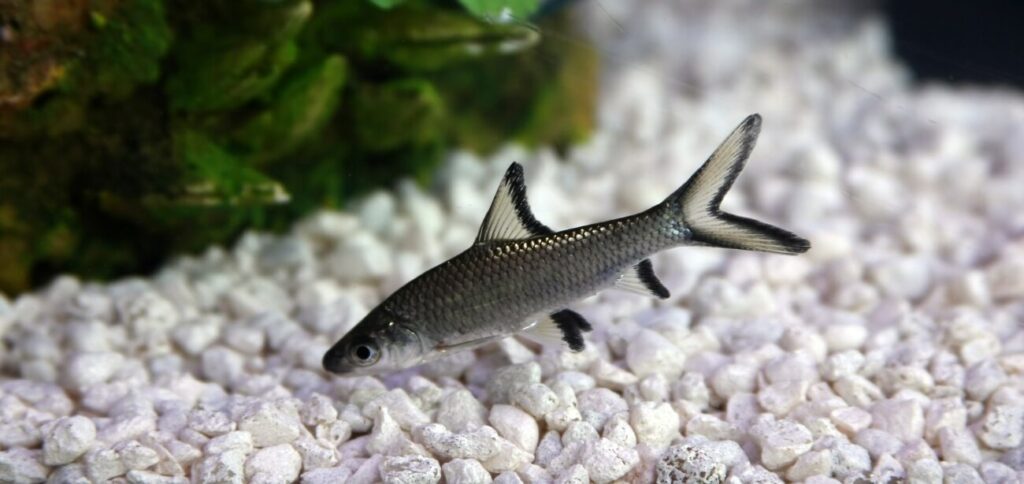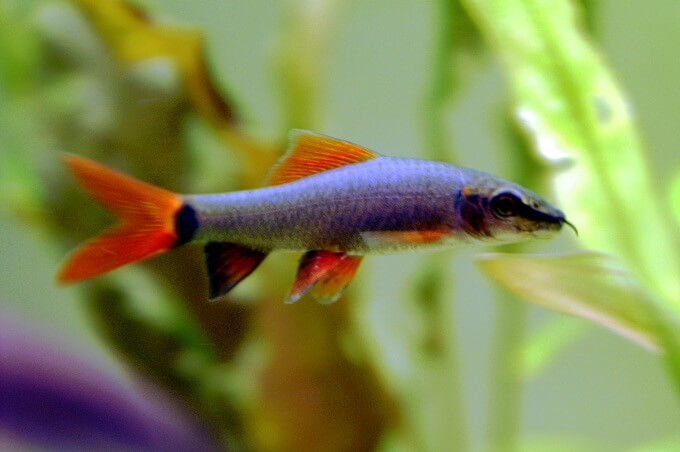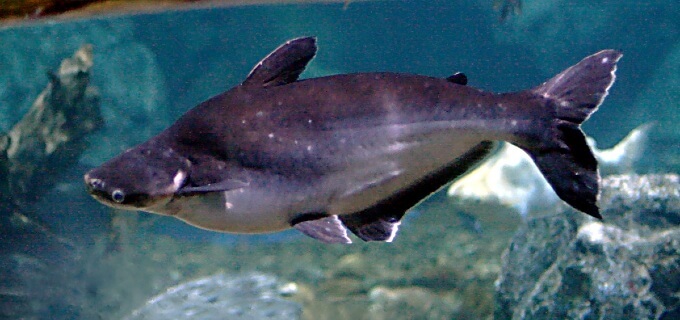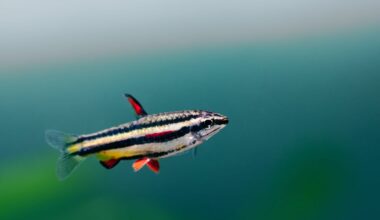The interest in freshwater aquarium sharks has been growing rapidly in recent years. People can’t get enough of them!
There’s something so neat about owning a shark, no matter what species it is. These iconic fish have been a staple of our relationship with the water for hundreds of years.
Watching a freshwater shark swim around in your fish tank never gets old.
So here’s what we did:
We put together a complete list of the best freshwater sharks to keep in your aquarium. Some are large, some are small, but all of them are amazing!
Author’s note: We should mention that the many species mentioned in this article aren’t actually true sharks (which have fully cartilaginous skeletons), but rather various fish species (containing a bony skeleton). Advice on housing true sharks within your aquarium is for a future article down the road…stay tuned!
1. Bala Shark
Despite their somewhat intimidating looks, Bala Sharks are considered to be gentle giants. They are relatively peaceful and get along well with a wide range of fish. While they can start to view smaller critters as food when they get bigger, they tend to be respectful towards most fish. Additionally, other common names for bala sharks include the tricolor shark, silver shark or the shark minnow.

Bala Sharks are very active swimmers. They will spend hours swimming around their environment. When kept in groups, the fish will exhibit schooling behavior as well.
From an appearance standpoint, these freshwater aquarium sharks are stunning. Typically, the primary color of the shark is going to be gray. Some color variations do exist, but most are going to look fairly similar.
The gray color is complemented by impactful yellow and bright stripes. The stripes are found on their forked tail and fins. Like most shark-like species, the dorsal fin of the Bala Shark is very prominent. Thanks to its striking coloration, the dorsal fin stands out when it is perked up at attention.
Bala Sharks aren’t too difficult to care for. Though, they do require some stringent water conditions and a good diet to stay healthy. The sharks prefer temperatures around 77 degrees Farenheit at all times. The pH balance should be between 6.5 and 8.
These sharks are omnivores. However, they prefer protein-based snacks like bloodworms, brine shrimp, and more. They have big appetites and should be fed three times a day to support their growth.
- Size: 10 to 13 inches
- Difficulty: Intermediate
- Minimum Tank Size: 120 gallons
2. Red Tail Shark
Red Tail Sharks have been a popular fish species in the aquarist community for quite some time. They were originally found in freshwater lakes and swamps throughout Thailand. However, they are now considered to be critically endangered in the wild.

To make matters worse, breeding these fish in captivity is no easy task. While it’s possible and is successfully done by some larger professional breeding facilities, no established at-home breeding technique has been found.
It’s not hard to see why these fish are so revered. The Red Tail Shark is aptly named for its striking red tail. It’s a stark contrast to the rest of the shark’s body, which is dark black. Of course, this species also has that iconic shark profile that so many fish-keepers are after.
The good news is that these fish are very hardy and can therefore adapt well to various environments. Preferred temperatures range from 72 – 79 ℉. A standard pH balance between 6.5 and 7.5 is important too.
Aggressive behavior is common in this species.. The Red Tail Shark is highly territorial and will lash out at any creature that crosses into its domain. To minimize fighting, the Red Tail Shark needs plenty of space to call its own.
- Size: 6 inches
- Difficulty: Intermediate
- Minimum Tank Size: 55 gallons
3. Rainbow Shark
Sometimes referred to as Ruby Sharks or Red-Finned Sharks, these creatures offer a nice pop of color to any freshwater tank. Like the Red Tail Shark, the Rainbow Sharks have a fiery red tail that stands out against a natural backdrop. However, in addition to their colorful tails, these fish also have bright red fins.

The fins are semi-transparent, allowing you to see delicate rays. Every single fin is colored red – pair that color with the dark black shade of their body and you have a very intimidating-looking fish.
Rainbow Sharks generally aren’t recommended for beginning aquarists. The reason for that is aggression. These are very territorial fish that are known to attack other creatures in the tank. It’s an interesting behavioral trait that’s not usually found in this species when observed in the wild.
However, even with their aggressive behavior, Rainbow Sharks can be kept with other fish. They are bottom-dwellers, so you can keep them with fish species that stick towards the top of the water column. Aggression is still possible, so you should always exercise caution.
Rainbow Sharks are natural omnivores. Throughout the day, they will chow down on algae they find throughout the fish tank. Though, this should be supplemented with sinking fish food, blanched vegetables, and some high-quality live food.
- Size: 6 inches
- Difficulty: Beginner-Intermediate
- Minimum Tank Size: 55 gallons
4. Iridescent Shark
Native to Southeast Asia, Iridescent Sharks are a big commitment. Not only do they get large, but these fish are known to live 20 years or more! As a result, they’re regarded as species that only seasoned aquarists should keep.

If you ever see one of these fish in person, you might be confused as to how they get their name! Adult Iridescent sharks are usually solid dark gray in color. Truth is, that muted tone is something that forms slowly as the fish gets older. As juveniles, the Iridescent Shark is covered in dark shiny skin that shines in the light.
Aside from their coloring, these are very interesting looking freshwater sharks for your fish tank. They have that familiar catfish-like head complete with barbels, hence the alternate name Iridescent shark catfish. However, their bodies are quite bulbous. The fins are quite large and fan-like as well, giving the fish a unique profile.
Overall, Iridescent Sharks are not too fussy about their environments. They like temperatures between 72 and 79℉, standard pH levels between 6.5 and 7.5, and natural decor. That said, feeding can be a bit of a challenge…
These sharks need a lot of food. Not only that, but there needs to be some variety to ensure that they are getting all their nutrients. These fish are omnivores that will eat pretty much anything, so make sure to mix things up.
- Size: 3-4 feet
- Difficulty: Expert
- Minimum Tank Size: 300 gallons
5. Violet Blushing Shark
Unlike other freshwater aquarium sharks, the Violet Blushing Shark (or Labeo boga) is quite passive. It doesn’t exhibit territorial behavior like you would see with other species. As a result, they do well in community tanks.

That said, you should still avoid keeping these fish with smaller creatures that they can view as food. They do best when kept with medium-sized fish.
Violet Blushing Sharks get their name from their unique appearance. The fish are covered in a silvery-white color. You can see some sheen on their bodies, but only if they are under some powerful lights.
Their bodies are transparent, allowing you to see individual organs. The most prominent feature of the shark’s body is the gills. The gills are visible through the body, making it look like fish is blushing!
Keeping a well-maintained tank is crucial for these fish. They need stable temperatures between 68 and 78 ℉ to stay healthy. That’s not all…the Violet Blushing Shark needs to have a lot of swimming space, too, due to the eventual large adult size of this species.
The biggest mistake newer aquarists make with this species is filling the tank with too many decorations. Plants, driftwood, and rocks are all important for making the fish feel comfortable. But so is plenty of open swimming space! You’ll need to find the right balance to keep the Violet Blushing Shark in good shape.
Lastly, it is advised that while you can house a singular Violet Blushing Shark alone, you can also keep them in groups of 6 or more fish.
- Size: 12 inches
- Difficulty: Intermediate
- Minimum Tank Size: 125 gallons
6. Columbian Shark
Here’s a species that can be a big challenge to care for. Also known as the Blackfin Shark (not to be confused with number 7’s Black Shark), the Columbian Shark has some strict care requirements. Unfortunately, there’s a lot of misinformation floating around out there.
Contrary to popular belief, these aren’t entirely freshwater sharks. As juveniles, they require brackish water (water higher in salinity than fresh water) to stay healthy. When you’re setting up their fish tank, you’ll need to add some marine salt to ensure that the specific gravity is between 1.005 and 1.010.
Columbian Sharks also tend to be problematic when kept with other fish. These are predatory creatures that will hunt out smaller fish species, so you’ll need to avoid smaller, passive fish.
Another way that you can stave off predatory behavior within this species is to keep the fish well-fed. The Columbian Shark thrives on a high-protein diet of live and frozen food. They do well on pellets and commercial dry foods, too. However, they prefer live foods that they can hunt down.
From an appearance standpoint, these fish are one of the most shark-like species you can get for your aquarium. They have a large sail-like dorsal fin. Their bodies are typically covered in shades of black, gray, and silver.
On the heads of the fish, you’ll notice that they have several pairs of long barbels. These barbels are used to navigate their environment and hunt down food.
- Size: 10 inches
- Difficulty: Beginner-Intermediate
- Minimum Tank Size: 70 gallons
7. Black Shark
The Black Shark is a large fish species with a semi-aggressive nature. Originally found throughout Malaysia, these fish are very popular because of their foreboding appearance.

Covered in all black, the Black Shark has that familiar profile that many freshwater sharks share. This includes a massive dorsal fin. When the fish is swimming, the dorsal fin will usually lay relatively flat against their rounded body. However, it will also stand tall from time to time as the fish shows off.
The Black Shark can get very aggressive and predatory. They should not be kept with smaller fish species. Most aquarists will house them alongside other aggressive species that can handle the bullying nature of the Black Shark. This includes some Cichlid species.
Interestingly enough, these fish don’t need to have a diet built on pure protein. Some protein is good, but they are omnivores that will eat just about anything. They have a penchant for plant-based foods. In fact, these fish are notorious for eating plants.
Thus, the Black Shark is recommended for tanks that are sparse in the plant department. They do best with a lot of open swimming space. Plenty of caves are recommended as well so that they have places to rest.
- Size: 24 inches
- Difficulty: Intermediate
- Minimum Tank Size: 125 gallons
8. Roseline Shark
These eye-catching fish are absolute stunners! The Roseline Shark is covered in several bright colors that look great against a natural backdrop. You’ll see stripes of red, black, and gold. Patches of green and yellow are pretty common, too.

Like all freshwater sharks, these fish have a pronounced dorsal fin. In the case of Roseline Sharks, the dorsal fin is accented with a vibrant fiery red stripe.
Roseline Sharks are actually part of the barb family (they are also known as the Denison barb or the red-line torpedo barb) and are some of the smallest freshwater aquarium sharks you can get. However, this can be a good thing when it comes to temperament.
For the most part, these sharks aren’t going to be a problem in terms of aggression. They are quite peaceful and won’t pay any attention to other community fish. When kept in groups of four to six, these fish fare even better and will exhibit some playful behavior.
Roseline Sharks can tolerate a wide range of conditions as well. They can stay healthy in temperatures between 60 and 77℉, though somewhere in the middle is preferred. One thing they do need is a strong current. The fish are naturally found in rivers and streams, so replicating that natural current with a strong pump is essential.
- Size: 4.5 inches
- Difficulty: Beginner
- Minimum Tank Size: 50 gallons
9. Harlequin Shark
Scientifically known as Labeo cyclorhynchus, Harlequin Sharks are an interesting addition to freshwater tanks. They’re quite beautiful. However, the fish is known to live a very solitary life.
They don’t like to be around other fish. In fact, they are known to be very territorial against similar-looking species. That means you can’t keep them in groups or with other freshwater sharks.
You can, however, house them with some fish if you have enough room. The Harlequin Shark is a bottom-dwelling fish that will spend most of its time in hiding. Thus, they can be kept with larger species that stay towards the top of the water column (similar to the previously mentioned Rainbow shark).
In the wild, these fish are found throughout the Congo River Basin. Their natural habitat is densely planted forest streams. To truly thrive, Harlequin Sharks need a lot of hiding places. Hardy plants and a series of hiding nooks crafted out of driftwood or rocks is a must.
The act of feeding Harlequin Sharks isn’t too bad. They are algae-eaters that will spend their time feeding on anything they can find at the bottom of the tank. This includes algae, microscopic animals, and plant detritus.
You must also supplement their snacking. The fish do best when kept on a variable diet consisting of sinking pellets, blanched vegetables, and live or frozen foods.
- Size: 6 inches
- Difficulty: Intermediate
- Minimum Tank Size: 40 gallons
10. Chinese High-Fin Banded Shark
Chinese High-Fin Banded Sharks are a species that’s only viable for extremely large fish tanks or public aquarium installations. They are docile creatures that do just fine with others. They can be kept with a wide variety of fish without having to worry about aggressive behavior.

One requirement, however, is that they need to be kept in large groups. These are schooling fish that prefer to stay within the company of their own kind. Many aquarists have experienced issues keeping these fish alone. Some have even died when kept in solitude!
The Chinese High-Fin Banded Shark has a very iconic look. But, that look only applies to younger juvenile fish. When they are young, these sharks are brown with three vertical stripes.
As you might have guessed by their name, the dorsal fin is also very prominent. The main portion of the dorsal fin stands very tall. After the sail-like shape, the fin tapers down to a more modest size.
The interesting thing about the Chinese High-Fin Banded Shark is that those defining features fade once the fish gets bigger. The coloration starts to dull out a bit. Some specimens become solid-colored. The dorsal fin doesn’t grow with the fish either, making it look smaller into adulthood.
- Size: 4 feet
- Difficulty: Expert (recommended for public installations only)
- Minimum Tank Size: 800+ gallons
11. Silver Apollo Shark
While most freshwater aquarium sharks are bottom-dwellers, the Silver Apollo Shark likes to stick to the surface. It’s a highly active fish that will spend its time skimming the top of the waterline in search of food. At times, they will also venture to the bottom to find prey.
Speaking of which, the Silver Apollo Shark can be quite aggressive. It’s a predatory fish that will seek out smaller prey any chance it gets! As such, they need to be kept in tanks with larger semi-aggressive species.
Silver Apollo Sharks are also shoaling fish, who socialize by hanging out with other fish in loose groups, in the same place (which is different from schooling fish who all swim in the same direction, together). Therefore, they do best when kept in large groups. The fish will swim together and stay safe against other aggressive species in the tank.
Free swimming-space is a must for Silver Apollo Sharks. They live in fast-moving streams in the wild, so they are powerful swimmers. They can often be seen darting across the tank for hours on end.
These fish are built for swimming. They’re sporting a torpedo-shaped body that’s usually olive green in color. A dark horizontal line runs the length of the fish as well. The snout of the fish is pointed and has some short whiskers.
The dorsal fin is quite large like other freshwater aquarium sharks. However, it’s set far back on the body, putting it much closer to the tail.
- Size: 7 inches
- Difficulty: Intermediate
- Minimum Tank Size: 120 gallons
Wrapping Up
Now that you’ve seen the full list of popular freshwater aquarium sharks, it’s time to pick the ones you’re most interested in.
While some of them might be too large to consider for your setup at home, many of the smaller sharks on this list are totally viable.
No matter what your level of experience is (or the amount of time you wish to spend), there should be a species for you!
If you have any questions about a species on this list, we’re more than happy to help you out. Freshwater sharks are some of our favorite fish!

